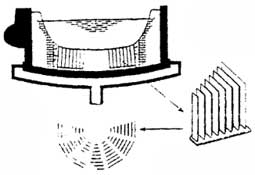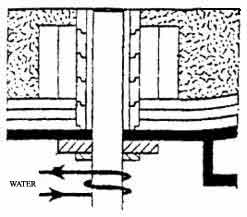| DonNTU |
Master's portal |
Theme of master's work: "Exploration of thermal work bottom anode of a DC-EAF with the purpose of optimization of its design and working conditions"
Materials on the theme of master's work
 Polyak_VO@mail.ru
Polyak_VO@mail.ru
UKR RUS
Master's work
Introduction

Recently in the world spreading receives the electrothermal equipment which works on a direct current. Steel furnaces which work on a direct current, have current-carrying bottom, or bottom anode, and one roof electrode (in rare cases two roof electrode), located in the center of the furnace. These furnaces enable to improve operating techniques and to create new, to ensure excellence of metal at use of ordinary cheap mix material, including that, what hard gives in to processing. New furnaces and electrotechnological process in them have high indexes on technical, economic and ecological parameters. In electric arc furnaces of direct current (DC-EAF) advantages of electroarc heat are realized, its opportunities are develop and augmented, the basic deficiencies are liquidated.
Thus, electric arc furnaces of a direct current have following advantages:
- lowering specific expenditures of the electric power on ton of production on 10-12 %;
- lowering expenditures of graphitic electrodes in 2 - 5 times at depending of preparation of mix material;
- increase in a recovery ratio at 4 % - of 6 % (in ore heat-treating furnace);
- improvement of ecological indexes, lowering dust and gas purification in 3 - 5 time, noise on 25 - 30 %;
- reduction of an intoxication of technological components on 30 - 70 %;
- an opportunity of use of electrochemical reactions on a direct current for removal of harmful admixtures and improvement of quality of production;
- increase in life expectancies of lining;
- heightening a resource of high-voltage transformers and cutout switches, lowering of "flicker-effect" in 2 - 5 times;
According to the foreign information and operating experience at the factory’s re-equipment of furnaces of an alternating current on power supply by a direct current pays off for one year.
Survey part
One of basic elements DC-EAF is the construction of a supply of a current to mix material. For a supply of a current to a remelded material in such furnace use or current-carrying bottom from carboniferous materials which minus is the lowered resistance and additional carbonizing liquid metal. Or use bottom anodes which are one of weak spots such EAF. BE can have different constructions and can be fabricated by different ways. Now such types of electrodes are known:
1) Pin-type anode. Represents a great many of fine rods which ends are fixed on a steel slab. The steel slab cooled by air and it is bridged to the water-cooled funnels connected to the power supply (see fig. 1).

Fig. 1 - Pin-type anode.
2) Fin-type anode. In this case as a conductor of a current through bottom use thin metal plates. They are welded in section and located on a circle inside of the cooled by air bottom door of the furnace and fixed on it by bolts (fig. 2).

Fig. 2 - Fin-type anode.
3) Billet-type anode. Design features of such electrode are: use of a bimetallic rod which powers up steel (upper) and copper (lower) the parts, more often received by a method of electroslag remelting process, and also water refrigeration of a copper part of an electrode (fig. 3).

Fig. 3 - Billet-type anode.
 In this master's work is supposed to examine the most spreaded billet-type anode.
In this master's work is supposed to examine the most spreaded billet-type anode.
Bottom electrode is intended for introduction of electric power in the electric arc furnace of a direct current, and is the anode. Such electrode install in lining of a furnace bottom, and during the smelt it is be in electric contact to electrowire mix material or a bath of a liquid melt.
At maintenance DC-EAF in a bath of a melt usually there are the significant convective streams called by electrodynamics forces and overheating of a melt in a place of contact with bottom anode. Consequence is the heightened lining wear around of an electrode that strengthens a heat-away from both to an electrode and result on to its overheating, and further to its premature outage.
At maintenance BE the steel part of a rod can fractionally pass in a liquid condition from a both of a melt, and after removal of electric power it is recovered due to crystallization in conditions of a fixed heat-conducting at calculated cooling conditions.
For good safety maintenance bottom anode is stipulated monitoring temperature of a rod of an electrode, and lining in the field of its installation. Conditions of safe maintenance bottom anode are: correctness of its installation in furnace, integrity of lining, good electric contact to mix material (or bathroom of a melt) and calculated cooling conditions.
The conclusion
During performance this master’s work are planed the theoretical calculations with the purpose optimization of a construction and working conditions bottom anode, and also mathematical simulation with the purpose to exploration the thermal work of bottom anode electric arc furnace of a direct current.
At this moment on the basis of mathematical simulation on the computer are fabricated explorations of influence of intensity of refrigeration bottom anode on its thermal condition.
Literature

1. И.Ю. Зиннуров, Ю.Н. Тулуевский, Ю.В. Нафтолин, А.Д. Киселев. Новая конструкция подового электрода для высокомощных дуговых сталеплавильных печей постоянного тока. Труды третьего конгресса сталеплавильщиков. Москва, 1996 г.
2. В.С. Малиновский, И.Б. Власова "Универсальные дуговые печи постоянного тока нового поколения – высокоэффективное оборудование для литейных производств", Индустрия, № 4/42, 2005 г.
3. В.М. Сафонов, А.Н. Смирнов. Современная электродуговая печь: основные параметры и концептуальные решения// Металлургическая и горнорудная промышленность, 2004 - №8 – С. 14 – 25.
4. Афонаскин А.В., Андреев И.О., Князев Д.В., Малиновский В.С., Малиновский В.Д. «Об эффективности работы дуговых печей постоянного тока нового поколения при выплавке чугуна и стали». Труды VII Съезда Литейщиков России. Новосибирск, 2005 г.
5. Малиновский B.C. "Подовый электрод". А.с. по заявке 2543436/07, 1977 г.
6. Х. Хушка, Х. Мюллер. Сравнительный анализ электросталеплавильных дуговых печей переменного и постоянного тока. Труды третьего конгресса сталеплавильщиков. Москва, 1996 г.
7. В.С. Малиновский. "Подовый электрод электропечи". Патент РФ № 2112187.
8. Danieli Centro Met "New Danieli Strategy in DC-EAF Technology", 114 Vol.1, 1995 year.
9. Малиновский B.C. и др. «Устройство для контроля состояния подового электро¬да». А.с. 438368, 1973 г.
10. А.В. Афонаскин, И.Д. Андреев и др. Результаты первого этапа освоения дугового плавильного агрегата постоянного тока нового поколения на ОАО "Курганмашзавод". Литейное производство, № 11,2000 г.
11. Е.И. Казанцев «Промышленные печи», М: Металлургия, 1975г.
12. Калмыков В.А., Карасев В.П. Электрометаллургия стали: Учеб. пособие. СПб.: Изд-во СПбГТУ, 1999. 292 с.
13. И.М Ячиков, И.В. Портнова. Моделирование электромагнитных процессов протекающих в ванне расплава ДППТ. Сообщение 1.// ИЗВЕСТИЯ высших учебных заведений. ЧЕРНАЯ МЕТАЛЛУРГИЯ, 2005 - №7 – С.27 – 29.
14. И.М Ячиков, И.В. Портнова, В.Н. Манагаров. Моделирование электромагнитных процессов протекающих в ванне расплава ДППТ. Сообщение 2.// ИЗВЕСТИЯ высших учебных заведений. ЧЕРНАЯ МЕТАЛЛУРГИЯ, 2006 - №11 – С.23 – 26.
15. http://www.stf-ecta.ru - Official site of Open Company «НТФ ЭКТА».
| DonNTU |
Master's portal |
Electronic library | Links |


 UKR
UKR




 In this master's work is supposed to examine the most spreaded billet-type anode.
In this master's work is supposed to examine the most spreaded billet-type anode.
